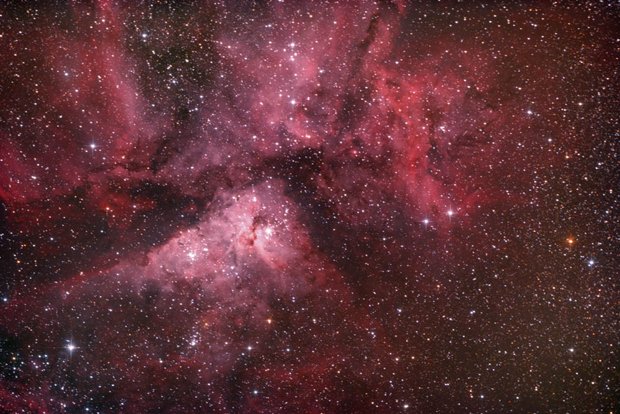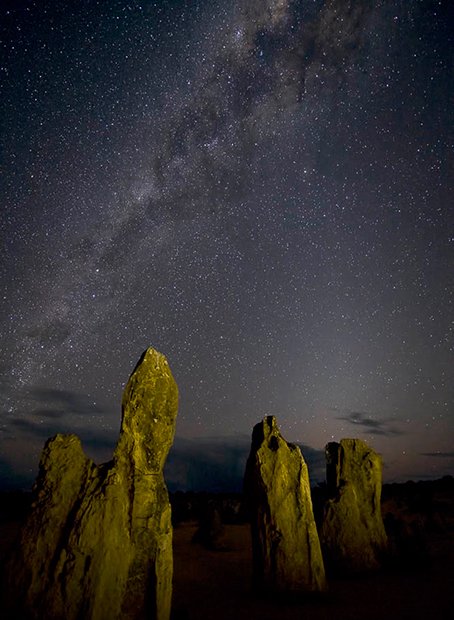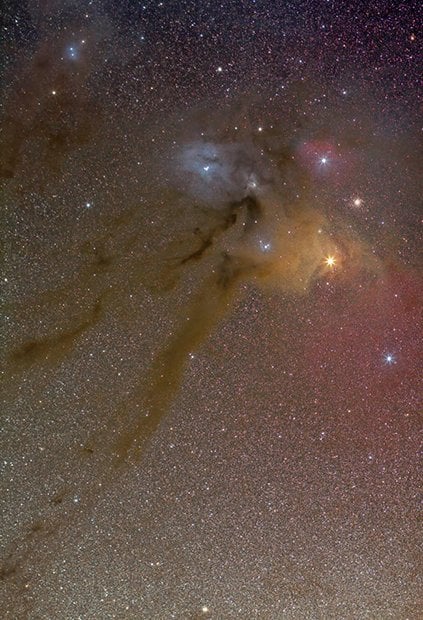Gallery: Best astronomy photographs

Speared Emu
by Alex Cherney
Dark clouds in the Milky Way form a life-like impression of an emu — a celestial figure featured in the stories of Indigenous groups across Australia. Here comet Lovejoy (C/2011 W3) appears like a spear in the emu’s body.
Winner, Wide Field category

Bright Night
by Grahame Kelaher
Long exposure images of the night sky illuminated by the Moon show it is blue – just like during daylight – even if our eyes cannot see this. In this image, taken in Western Australia, the Moon is hidden behind a limestone pinnacle.

Star Trails over Lake Wivenhoe
by Stephen Mudge
Star trails – like these, photographed in Queensland – are the simplest astrophoto technique. Just aim a stationary camera and open the shutter. Software is now available to combine multiple short exposures to simulate long-exposure star-trails.

Totality over Tikahana Motu
by Geoff Sims
A total solar eclipse is a spectacular astronomical experience. Each one is visible from a limited strip of the Earth’s surface.

Melbourne Moon
by Phil Hart
“A busy but very interesting shot of the Williamstown dockyards dominated by a full moon, all of it pervaded by a mistiness that adds colour and softens an industrial subject,” says David of the Melbourne photograph. “It is a strong, eye-catching image.”
Winner, Solar System: Wide Field category
Overall Winner

IC5067
by Martin Pugh
This cloud of gas and dust in the constellation of Cygnus is a nursery for stars.
Winner, Deep Sky category

King of Pain
by Peter Ward
“This is a superb image,” says David. “The lyrics of the song King of Pain, by The Police, apparently have the line ‘There’s a little black dot on the Sun today’.”
Winner, Solar System: Hi-res category

Emu Crossing
by Richard Tonello
The full beauty of the Milky Way is only visible where light pollution does not mask its faint light, such as remote Australia.

Crown Jewels above Lake Tekapo
by Alex Cherney
The Milky Way hovers like a jewelled tiara over Lake Tekapo, New Zealand.
Winner, Photo Editor’s Choice Award

Santa’s Sleigh Trail
by Wayne England
The white trail is visible due to dust particles scattering the sunlight.

Cycle 24
By Paul Haese
Magnetic activity in the Sun’s outer layers flows and ebbs over 11 years. The 24th cycle since measurements began has kicked off, with a show of bright flares and rippling polar auroral displays.

Road to the Milky Way
by Mike Salway
The Milky Way is best seen on moonless nights.

Equinoctial Twins
by Geoffrey Wyatt
The mirage image here is a result of light from the Sun bending upwards as it passes through the warmer air near the ocean’s surface. The upper ‘twin’ is the real Sun.

NGC 3372 — The Great Nebula in Carina
by Nathan Coleman
This gas cloud not far from the Southern Cross contains the massive star Eta Carinae. In the 1840s this unstable star shed a cloud of dust and disappeared from naked-eye view for over a century. Eta Carinae is visible here just below-left of centre.

NGC 5128: Centaurus A
by Nathan Coleman
This galaxy, approximately 13-million-light-years beyond the stars of the Milky Way, is a prodigious source of radio energy. “The stars are round and nicely coloured,” says David of the junior winner. “I’m impressed that Nathan has got his head around the challenging software.”
Winner, Junior category

Pinnacles Desert Starscape 1
by Zane Hammond
The Milky Way is our home galaxy. It consists of stars and planets, gas, dust and a vast amount of invisible dark matter. We see its spiral disk from within, but edge-on.

The Blue Horsehead to Rho Ophiuchi
by Greg Bradley
The Milky Way contains a mind-boggling number of stars, around one hundred thousand million.

Jupiter from Exmouth, WA
by Anthony Wesley
Jupiter, king of the planets, displays a dynamic surface of swirling clouds.

Eastern Veil Nebula
by Martin Pugh
A ghost-like cloud of wispy gas hovers in the constellation Cygnus.

Partially Lunar over Luna
by Trent McDougall
This image depicts the Moon rising over Luna Park, Sydney.
Winner, Open Theme Category, ‘Symmetries’

Antares Region
by Gary Hill
The birth of stars is hidden inside dark clouds. The hottest stars flood the cloud in ultra-violet light causing it to glow red and disperse.

Super Moon Cruise
by Stephanie Hough
The dark patches on the Moon are called mare, or seas, and were once thought to really hold water. We now know the Moon is bone dry — except for ice deposited by comets in permanently shaded polar craters.

Night Market
by Jason Jennings
A smorgasbord of galactic components: glowing red hydrogen gas, white clouds of thousands of stars, dark clouds of gas and dust, and a cluster of young, hot blue stars.

Home Topics Science & Environment Gallery: Best astronomy photographs


